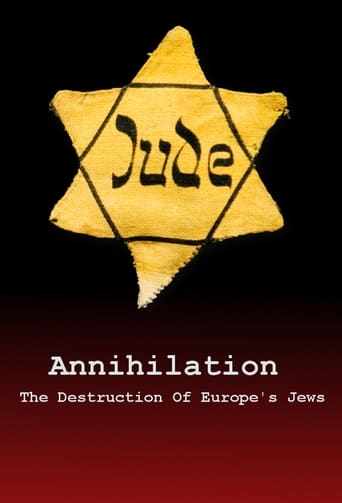Annihilation: The Destruction Of Europe's Jews Season 1

Seventy years after Auschwitz’s liberation, this documentary film collection sets out to examine a story whose roots begin before the dawn of the 20th century - a story which is still being played out today. Divided into 8 episodes, the films will travel back to the roots of the genocide.
Watch NowWith 30 Day Free Trial!
Annihilation: The Destruction Of Europe's Jews
2015
Seventy years after Auschwitz’s liberation, this documentary film collection sets out to examine a story whose roots begin before the dawn of the 20th century - a story which is still being played out today. Divided into 8 episodes, the films will travel back to the roots of the genocide.
Watch Trailer
Annihilation: The Destruction Of Europe's Jews Season 1 Full Episode Guide
Last in the deeply moving series about the Holocaust. While the hunt to find surviving Nazis continues today, efforts are being made to preserve the memory of their tragic victims.
By summer 1942, deportations were systematic across those parts of Europe occupied by the Nazis. The convoys which arrived in Auschwitz-Birkenau came from Poland, but also from western and southern Europe. Hitler issued an order for all Polish Jews to be killed before December 1942. The pace of deportations once again picked up, and the children from the ghetto of Lodz were deported starting from early September. The death camps had to be reorganized to deal with the greater number of people. But the war was changing - the Soviet victory in Stalingrad and things were starting to tip in the Allies' favour. Himmler ordered the units of Special Action 1005 - which had been responsible since 1942 for disposing of evidence of the mass shootings which had accompanied Operation Barbarossa in the summer of 1941 - to erase all trace of the genocide in the extermination camps.
By summer 1942, deportations were systematic across those parts of Europe occupied by the Nazis. The convoys which arrived in Auschwitz-Birkenau came from Poland, but also from western and southern Europe. Hitler issued an order for all Polish Jews to be killed before December 1942. The pace of deportations once again picked up, and the children from the ghetto of Lodz were deported starting from early September. The death camps had to be reorganized to deal with the greater number of people. But the war was changing - the Soviet victory in Stalingrad and things were starting to tip in the Allies' favour. Himmler ordered the units of Special Action 1005 - which had been responsible since 1942 for disposing of evidence of the mass shootings which had accompanied Operation Barbarossa in the summer of 1941 - to erase all trace of the genocide in the extermination camps.
Leading historians reflect on the barbarity of the Holocaust. By 1941, the Nazis were using gas as the hideous method for mass killings at their death camps - including Auschwitz.
Leading historians reflect on the barbarity of the Holocaust. By 1941, the Nazis were using gas as the hideous method for mass killings at their death camps - including Auschwitz.
By June, Nazi Germany had occupied Paris. France was cut in two: north of the demarcation line was the German-occupied zone, to the south was a zone headed by Marshal Pétain, whose seat of government was in the central spa town of Vichy. The Vichy regime very quickly, and without pressure from the Germans, passed the first Jewish laws. With the first of these, prefects in the southern zone had the right to lock up foreign Jews and Jewish refugees in camps.
In 1938, the Third Reich, which had just annexed Austria, was applying a policy of systematic expulsion of foreign Jews resident on its territory. By 1 January 1939, there were no longer any Jewish businesses on Reich soil. The situation of German Jews grew worse: banished from German society, demonised by the regime, they were presented as the enemy within, but no longer had any possibility of leaving the country. The invasion of Poland by the Reich, on 1 September 1939, dragged Europe into the Second World War but war was just the start of the horror that was to come.
Germany, 1933. Adolf Hitler, at the head of the Nazi Party, has just become Chancellor and is faced with leading a republic in the throes of economic crisis and rampant inflation. Hitler used the cult of personality nurtured by his propaganda chief Joseph Goebbels, who spread the Nazis xenophobic and anti-Semitic ideology which Hitler had been touting since the First World War and which he reiterated in Mein Kampf: the Jews, he claimed, were part of an international conspiracy against Germany.
Free Trial Channels
Seasons


























